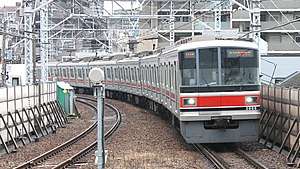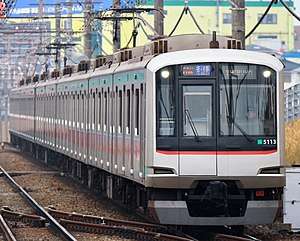Tokyu 3000 series
The Tokyu 3000 series (東急3000系, Tōkyū 3000-kei) is a Japanese commuter electric multiple unit (EMU) train type operated by Tokyu Corporation in the Tokyo area since 1999.[2]
| Tokyu 3000 series | |
|---|---|
 3000 series set 3006 on the Mita Line in December 2019 | |
| Manufacturer | Tokyu Car Corporation |
| Constructed | 1999 – 2001 |
| Entered service | 16 April 1999 |
| Number built | 78 vehicles (13 sets) |
| Number in service | 78 vehicles (13 sets) |
| Formation | 6 cars per set |
| Fleet numbers | 3001 - 3013 |
| Operator(s) | Tokyu Corporation |
| Depot(s) | Motosumiyoshi |
| Line(s) served | Tokyu Meguro Line, Tokyo Metro Namboku Line, Toei Mita Line, Saitama Rapid Railway Line |
| Specifications | |
| Car body construction | Stainless steel |
| Car length | 20,300 mm (66 ft 7 1⁄4 in) (end cars) 20,000 mm (65 ft 7 3⁄8 in) (intermediate cars)[1] |
| Width | 2,820 mm (9 ft 3 in)[1] |
| Height | 4,065 mm (13 ft 4 in)[1] |
| Doors | 4 pairs per side |
| Maximum speed | 110 km/h (70 mph) (service)[1] 120 km/h (75 mph) (design)[1] |
| Traction system | Variable frequency (IGBT)[1] |
| Acceleration | 3.3 km/(h⋅s) (2.1 mph/s)[1] |
| Deceleration | 3.5 km/(h⋅s) (2.2 mph/s) (service) 4.5 km/(h⋅s) (2.8 mph/s) (emergency)[1] |
| Electric system(s) | 1,500 V DC Overhead wire |
| Current collection method | Pantograph |
| Bogies | TS-1019 (motored)[1] TS-1020 (trailer)[1] |
| Safety system(s) | ATC-P, Tokyu ATS, ATO[1] |
| Track gauge | 1,067 mm (3 ft 6 in) |
Operations
The 3000 series sets are used on Tokyu Meguro Line and Tokyo Metro Namboku Line, Toei Mita Line, and Saitama Rapid Railway Line inter-running services.[2]
Formations
As of 1 April 2016, the fleet consists of 13 six-car sets based at Motosumiyoshi Depot, formed as follows with three motored (M) cars and three unpowered trailer (T) cars. Car 1 is at the Meguro (northern) end, and car 6 is at the Hiyoshi (southern) end.[3]
| Car No. | 1 | 2 | 3 | 4 | 5 | 6 |
|---|---|---|---|---|---|---|
| Designation | Tc2 | M2 | M1 | T | M | Tc1 |
| Numbering | 30xx | 325x | 32xx | 35xx | 34xx | 31xx |
- The "M" and "M1" cars are each fitted with two single arm pantographs.[3]
- Car 4 is designated as being mildly air-conditioned.[3]
Original 8-car formation
The first set, 3001, initially ran as an eight-car formation (on the Tokyu Toyoko Line), as shown below, with the Tc2 car at the Shibuya (northern) end.[1]
| Designation | Tc2 | M2 | M1 | T | T' | M2 | M1 | Tc1 |
|---|---|---|---|---|---|---|---|---|
| Numbering | 3001 | 3251 | 3201 | 3501 | 3502 | 3252 | 3502 | 3101 |
| Capacity (seated/total) | 48/141 | 51/151 | 54/151 | 54/151 | 54/151 | 51/151 | 54/151 | 48/141 |
The two M1 cars each had two single-arm pantographs.[1]
Interior
Seating is longitudinal bench seating throughout.[2] Wheelchair spaces are provided in cars 2 and 5.[3]
 Interior view
Interior view A wheelchair space
A wheelchair space
History
The first 3000 series set, 3001, entered service in 1999, initially as an eight-car formation used on the Tokyu Toyoko Line.[2] This was subsequently reformed as a six-car set following delivery of the rest of the fleet destined for the Meguro Line.[2] A total of 13 six-car sets (78 vehicles) were built by 2001.[2]
 Original 8-car set 3001 on the Tokyu Toyoko Line in April 1999
Original 8-car set 3001 on the Tokyu Toyoko Line in April 1999
References
- 東急3000系 [Tokyu 3000 series]. Japan Railfan Magazine (in Japanese). Vol. 39 no. 458. Japan: Koyusha Co., Ltd. June 1999. p. 70–77.
- 私鉄車両年鑑 2012: 大手15社営業用車両完全網羅 私鉄車両年鑑2012 [Japan Private Railways Annual 2012] (in Japanese). Tokyo, Japan: Ikaros Publications Ltd. February 2012. p. 144. ISBN 978-4-86320-549-9.
- 私鉄車両編成表 2016 [Private Railway Rolling Stock Formations - 2016] (in Japanese). Japan: Kotsu Shimbunsha. 25 July 2016. p. 67. ISBN 978-4-330-70116-5.
| Wikimedia Commons has media related to Tokyu 3000 series. |
